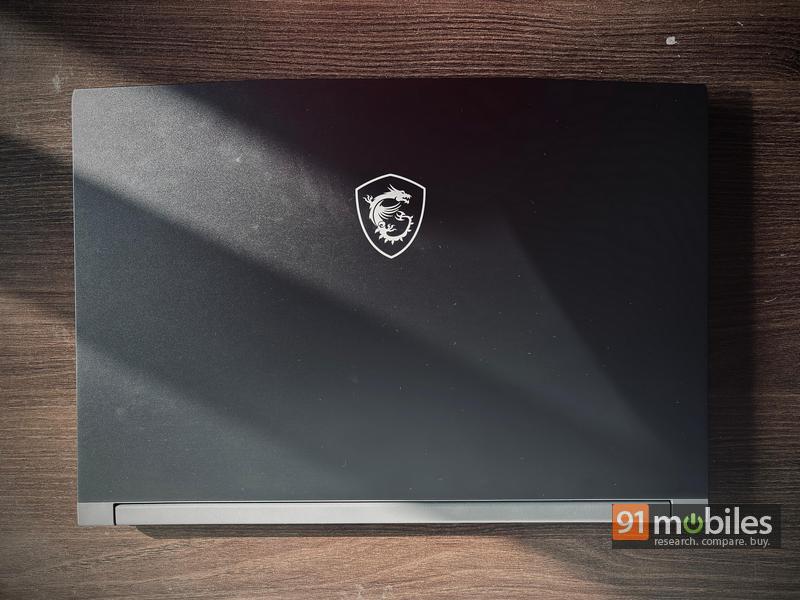MSI has introduced a new contender in the entry-level gaming laptop market. Previously, we reviewed the HP Victus 15 as one of the most affordable gaming laptops, and now the MSI Thin 15 has arrived at an even lower price point. Here’s a full review to see if the MSI Thin 15 outperforms its competition and is worth buying.
Design and display
MSI’s iconic curved top lid makes a return with this model. While it doesn’t scream ‘gaming’ without the bright RGBs, the unique shape and brand logo make it unmistakably MSI. The design has a clean, minimal aesthetic with dual-tone grey accents. However, one drawback is that you can’t open this laptop with one hand as the bottom lifts along with the lid.
The brand combines metal for the keyboard deck and top lid with plastic for the bottom half. While this might seem like a cost-saving choice, it helps reduce weight. However, it does mean the structure isn’t entirely rigid, with a slight flex in the deck while typing. The bottom features a large mesh offering a peek at the copper heat pipes, with vents located at the rear and left side for airflow. The dual fans become audible when gaming or performing other intensive tasks.
Despite being a gaming laptop, the MSI Thin 15 weighs just 1.86 kilograms. While ‘Thin’ here doesn’t mean ultralight, it does indicate a slim machine. For a notebook with a discrete GPU, its weight and 21.7mm thickness make it as portable as a standard laptop. For comparison, the HP Victus 15 is over 2mm thicker and about half a kilogram heavier.

On the front, the MSI Thin 15 sports a 15.6-inch IPS LCD display with an FHD resolution (1,920 x 1,080 pixels), 144Hz refresh rate, and a 45 percent NTSC colour gamut. Similar to many budget notebooks or entry-level gaming laptops we’ve reviewed, the display is good but not outstanding. The colours and viewing angles are decent, making it enjoyable for movies and gaming. However, creative professionals or anyone requiring high RGB colour accuracy might want to give this model a miss.
One major shortcoming of the HP Victus 15 was its 60Hz refresh rate display. I gave it some leeway since it was over Rs 10,000 cheaper than competitors. However, MSI demonstrates that a higher refresh rate is possible at this price point. The 144Hz refresh rate is ideal for competitive gamers who focus on online multiplayer titles like Counter-Strike 2 or Valorant, rather than AAA games.
Ports and audio
The MSI Thin 15 doesn’t have a particularly powerful audio system, but its twin 2W speakers are sufficient for everyday use, like watching videos or movies. While they’re loud enough in quiet settings, they can get drowned out in noisier environments. The laptop also supports Hi-Res Audio and DTS Audio.

For connectivity, this model includes a charging port, a USB Type-A (3.2 Gen1), and a charging LED indicator on the left. On the right side, it offers two additional USB Type-A (3.2 Gen1) ports, a USB Type-C (3.2 Gen1/DisplayPort), and separate 3.5mm jacks for microphone input and headphone output. At the back, there’s a single HDMI port supporting 4K output at 30Hz.
Keyboard and trackpad
Unlike other 15.6-inch laptops, MSI has opted for wider keys with ample spacing by skipping the numpad. The keys offer decent travel and spacing, making them ideal for gaming as this prevents accidental input. The keyboard also features a Blue LED backlight. A unique touch is the semi-transparent design on the WASD and arrow keys. While the WASD design isn’t unusual, I find the oversized arrow keys a bit unappealing.

Fortunately, these keys serve special functions that help make up for their design. One arrow key turns off the screen, another adds an on-screen crosshair, and you can even use them to play/pause media or adjust fan speeds. Below the keyboard is an off-centre trackpad aligned to the left, which is quite accurate and provides click feedback for both the left and right buttons.
Performance
Under the hood, the MSI Thin 15 comes equipped with an Intel 12th Gen Core i5-12450H processor, featuring Intel integrated graphics alongside a discrete Nvidia GeForce RTX 2050 graphics card. This GPU offers a maximum graphics power of 45W with Dynamic Boost. The laptop includes 16GB of dual-channel DDR4 3200MHz RAM and 512GB of NVMe PCIe Gen 4 SSD storage. For additional storage, there’s also a slot for a 2.5″ SATA HDD.
16GB of RAM should be the standard these days, which is why I’m glad the Thin 15 offers it. Some budget gaming laptops, like the Victus 15, still come with only 8GB, so this makes the Thin 15 a more capable option overall. Using synthetic benchmarks, we compared the laptop to the Victus 15, its main rival in this budget range along with the Lenovo LOQ 2024 (Review) and the Infinix GT Book (Review).
It’s worth noting that the Lenovo and Infinix models are priced over Rs 10,000 higher than MSI’s entry-level model. MSI’s affordable gaming laptop outperformed the HP Victus 15 in several benchmarks, including CineBench R23, PCMark 10, PCMark 10 Extended, GeekBench, Night Raid, and Time Spy. However, the Victus excelled in areas like Time Spy Extreme, Fire Strike Ultra, and Fire Strike Extreme. Overall, the performance is relatively similar, with most differences falling within single-digit percentages. The real performance gap becomes apparent with the more expensive Infinix GT Book, which comes with better specs.
Now, for the fun part: I put the MSI Thin 15 through a series of games, with a focus on Valorant, Forza Horizon 5, and Cyberpunk 2077. Pushing the laptop to its limits was Cyberpunk 2077, which managed a stable 29 fps with High Textures and Ray Tracing set to Ultra. Lowering the Ray Tracing settings while keeping the textures on High made the experience smoother. In Forza Horizon 5 on Extreme Preset with RT, the MSI Thin 15 achieved 28 fps. Dropping it to the Low preset saw it hit over 70 fps. However, you won’t hit triple-digit fps in Cyberpunk or Forza to fully take advantage of the 144Hz screen.

On the other hand, the gaming experience in competitive titles tells a very different story. Thanks to the 144Hz refresh rate, Valorant and CS2 ran incredibly smoothly, with no noticeable input lag. The high refresh rate provides a clear competitive edge. In Valorant, at High settings, the laptop averaged over 220 fps, although there were occasional dips to around 180 fps. Gaming did ramp up the fan noise quite a bit, with temperatures reaching as high as 85°C.
Another downside I encountered was with storage. While you can expand using a 2.5″ SATA HDD, the 512GB SSD just isn’t sufficient for modern games. Valorant alone takes up 50GB, and GTA V and Forza Horizon 5 each require over 110GB.
Battery
The MSI Thin 15 features a 52.4Wh 3-cell battery, paired with a 120W power adapter. While not the largest battery in its price range, it’s slightly smaller than the 52.5Wh battery found in the HP Victus 15. On the other hand, the Lenovo LOQ 2024 (60Wh) and Infinix GT Book (70Wh) are more expensive models that come with larger batteries. Despite this, the MSI Thin 15 proves to be more practical in terms of battery life when compared to HP’s budget offering. In the PCMark video battery test, the Thin 15 lasted 5 hours and 15 minutes before shutting down, nearly an hour longer than the Victus 15.
Verdict
While the HP Victus 15 features similar specs, its 60Hz refresh rate holds it back. It remains the only other gaming laptop we’ve recently reviewed in the Rs 40,000 to Rs 50,000 range, which I recommended primarily for casual gamers or those new to gaming.
In contrast, the MSI Thin 15 is a superior option for competitive players seeking a smooth experience in ranked matches. MSI has successfully combined capable performance, a smooth display, and robust hardware in a lightweight form factor. The 144Hz display and 16GB of RAM provide significant advantages for gaming, especially in fast-paced multiplayer titles, where high refresh rates and smoother frames make a noticeable difference.
However, this laptop does come with a few limitations, like high temperatures under load and limited storage. While it’s not aimed at AAA gaming at ultra settings, it can still deliver enough power for casual single-player titles. The MSI Thin 15 is a solid choice for gamers looking for a portable, budget-friendly laptop with enough edge to keep them competitive.
Editor’s rating: 7.5 / 10
Pros:
- Relatively lighter build
- Good performance on a budget
- 144Hz display is great for competitive games
Cons:
- Thermals can get high
- Can’t run AAA games consistently
- Unappealing keyboard design
img[data-m=”true”] {
display: none; visibility:hidden !important; height:0px;
}
The post MSI Thin 15 review: an affordable gaming laptop built for competitive gamers first appeared on TrakinTech News






